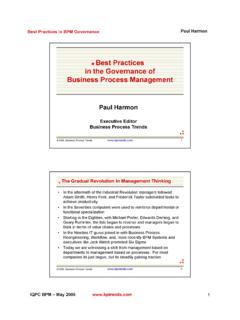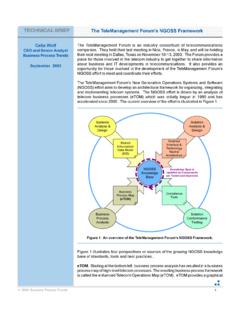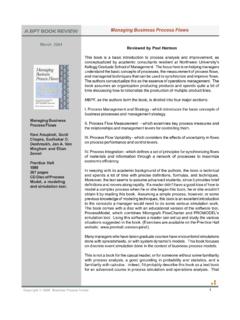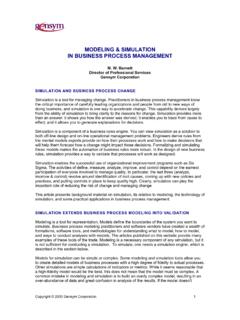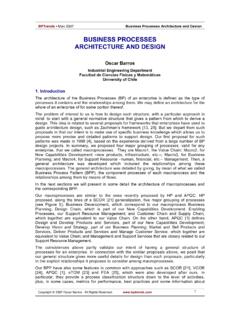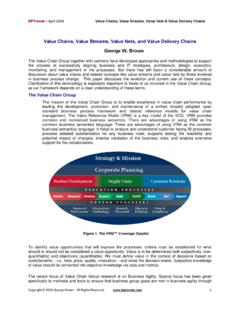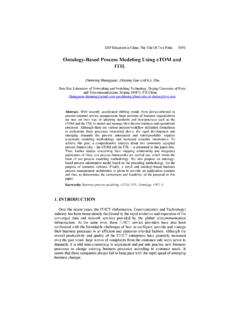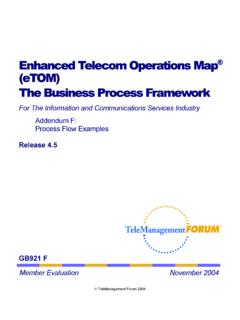Transcription of 03-11-2011-ART-Comparion of business modelling …
1 1 BPTrends March 2011 A Comparison of Common business Modeling Approaches to GODSC opyright 2011 Adrian Grigoriu All Rights Reserved. A Comparison of Common business Modeling Approaches to GODS Generic business Architecture Adrian Grigoriu Contents GODS single page generic business Architecture (gBA), in brief .. 2 Mapping scope and 3 Mapping scope .. 3 Mapping approaches .. 3 GODS compliance to ANSI/IEEE 1471 - ISO/IEC 42010 architecture Standard .. 4 Mapping to EA frameworks .. 4 Alignment to Zachman 4 Mapping to TOGAF s .. 5 Mapping to FEAF .. 5 Mapping to Porter s Value Chain ..5 Mapping to business process Frameworks .. 7 APQC process Classification framework mapping .. 7 Value Chain Group s Value Reference Model.
2 7 TM Forum s Frameworx process framework (eTOM ) mapping .. 8 Mapping to vendor frameworks ..8 IBM s CBM mapping .. 8 Microsoft s Motion 8 Mapping to the business Model 8 Analysis .. 16 Conclusions .. 16 business modeling frameworks comparison summary table .. 18 References .. 19 Abstract This Article attempts a lean comparison between some of the most employed business modeling approaches and the proposed GODS single page generic business Architecture (gBA), summarized in the first section. This work assists not only a positioning of the current enterprise modeling approaches versus the generic business architecture but also a comparison between the approaches themselves. For the purpose of this Article, the common denominator of the comparison is the process .
3 Mappings are limited to the top level of the process taxonomies. 2 BPTrends March 2011 A Comparison of Common business Modeling Approaches to GODSC opyright 2011 Adrian Grigoriu All Rights Reserved. GODS Single Page Generic business Architecture (gBA), in brief The single page GODS generic business Architecture consists of key Enterprise business functions interconnected by flows that implement the Enterprise structure and its operation. Figure 1. Mapping GODS generic architecture to Porter s Value Chain Figure 2. The GODS single page generic business architecture 3 BPTrends March 2011 A Comparison of Common business Modeling Approaches to GODSC opyright 2011 Adrian Grigoriu All Rights Reserved.
4 GODS stands for Governance, Operations Delivery and Support a basic taxonomy of the enterprise. The proposed generic business architecture is rooted in Michael Porter s Value Chain (Primary and Support activities) from which Support part, it splits and expands the Enterprise Governance and Development functions. It then overlays a proposed business function map and critical operational flows that characterise the business cycle: Plan, Create Demand, Produce, Sale/Fulfil Order (Satisfy Demand), Charge, Bill & Accrue Revenue and the After-Sales Service (and reverse supply chain). The Development, Support and Governance business flows are not illustrated (the Operations/Primary are) since, while interacting with most other functions, they are typically contained within the corresponding business functions.
5 Still, other typical business flows are depicted in the book (see References section). Enterprise stakeholders, beside customers, partners and suppliers, are not represented since accent is set on the model rather than its context. Also this reduces the clutter. The enterprise interacts though with many stakeholders in such fields as technology, labour and capital markets. It is also affected by such external factors as regulatory, competitors and new entrants. Mapping scope and approaches To prove the utility of the single page generic business architecture and ease a potential transition to its employ, this paper is investigating the mapping of most known business modeling approaches to this generic model.
6 Compliance to the ISO42010 architecture standard is considered beforehand. Mapping scope The enterprise modeling approaches considered for comparison are: Enterprise Architecture frameworks such as Zachman, TOGAF and FEAF Porter s Value Chain business process frameworks such as APQC, Value Chain Group s Value Reference Model Frameworx ( ) of TM Forum Microsoft s Motion and IBM s Component business Model (CBM) frameworks business Model representations such as Osterwalder et al. Mapping approaches The mappings are often self describing showing the alignment between taxonomies and Porter s Value Chain. 1. To ease alignment, a GODS process taxonomy is first created taking into account the fact that business architecture functions and flows essentially consist of processes which are is also the basic entity of most business modeling approaches (such as process frameworks, capabilities and component models).
7 business Functions are similar, if not same, to capabilities in Enterprise Architecture terminology. business Flows are comparable to Value Streams in xSigma methods. The mapping of a process is done to a GODS business function unless the process has an end to end flavour, in which case it will be done to a business flow. The mapping, rather than going into exhaustive detail, aims to show compatibility with other approaches but solely at the top level of the hierarchical process decomposition of a framework . When the framework consists of a matrix only one dimension is considered. Not all activities were illustrated in pictures because of lack of space in the diagram. 4 BPTrends March 2011 A Comparison of Common business Modeling Approaches to GODSC opyright 2011 Adrian Grigoriu All Rights Reserved.
8 2. Porter s Value Chain also eases mapping because it is a pattern found in both GODS and other modeling methods. It is also the most intuitive business modeling approach and oldest in use. 3. The GODS taxonomy level used in comparison is two. GODS Compliance to ANSI/IEEE 1471 - ISO/IEC 42010 Architecture Standard According to the standard, architecture is the fundamental organization of a system embodied in its components, their relationships to each other and to the environment and the principles guiding its design and evolution . And architecture can be described in Viewpoints/Views, essentially. The generic model proposed is an architecture in the sense of this standard in that it consists of components (functions) in relationships (flows).
9 By comparison, other methods typically consist of either business functions (or capability maps) or business flows (value streams). The model itself does not exhibit views since represents a business architecture in a picture. Still, views describing stakeholders viewpoints, in the sense of the 1471 standard, could and should be added to create the fully fledged business architecture. Mapping to EA frameworks The model is compared to Zachman and mapped to EA frameworks like TOGAF and FEAF. Alignment to Zachman s The generic business Architecture fits in the first two cells of the second row the What and How. Figure 3. GODS generic business architecture scope through a Zachman perspective 5 BPTrends March 2011 A Comparison of Common business Modeling Approaches to GODSC opyright 2011 Adrian Grigoriu All Rights Reserved.
10 Mapping to TOGAF s The generic model maps on the business architecture phase of the ADM development process . Figure 4. Mapping to TOGAF Mapping to FEAF The generic model maps on FEAF business Architecture at the top of the pyramid. Figure 5. GODS generic business architecture mapping on FEAF Mapping to Porter s Value Chain To ease mapping to other frameworks, the generic architecture was converted to a simple process taxonomy. Primary activities were mapped to GODS Operations. Enterprise development ones are extracted in a separate GODS Development function. Governance activities, not mentioned in Porter s, stand as a separate function in GODS. 6 BPTrends March 2011 A Comparison of Common business Modeling Approaches to GODSC opyright 2011 Adrian Grigoriu All Rights Reserved.

